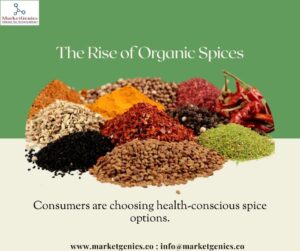In a world market propelled more and more by health and nutritional consciousness, concern for the environment and responsible consumption, organic spices have become a significant force within the sustainable food movement. A dramatic shift is noted towards the organic spice industry as consumers look for dietary alternatives without chemicals. Clean-label packaging and organic farming are part of the organic spice industry boom, reflecting higher societal values of health and environmental concern. Let’s see what MarketGenics have to say on the spice industry.
According to MarketGenics, the global organic spices market size was valued at around USD 30 billion in 2024 to around USD 48 billion by 2030, exhibiting a CAGR of 6.5 – 8% during the forecast period. This robust growth is attributed to increasing consumer awareness about the health hazards associated with synthetic pesticides and fertilizers, along with the broader trend toward sustainable living.
The North American and European markets dominate due to stringent food safety regulations and higher consumer disposable incomes, while Asia-Pacific is emerging as the fastest-growing region, driven by rising urbanization, e-commerce growth, and traditional knowledge of spices.

Despite promising growth, the sector faces several challenges:
Some of the most in-demand organic spices globally include:
These spices are not only staples in culinary traditions but are also key ingredients in health supplements, teas, and cosmetics.
Regulations and certifications play a pivotal role in shaping the organic spice industry. Key global standards include:
As of 2024, over 99 million hectares globally are under certified organic cultivation, supporting a thriving export economy for organic products, especially spices.
Innovations are helping bridge these gaps. Bio-inputs, such as bio-fertilizers and bio-pesticides, are becoming more accessible. Mobile apps are connecting farmers to organic certifiers and buyers. Social enterprises are aggregating farmer groups and providing training and market access.
Furthermore, spice cooperatives and ethical sourcing initiatives are linking organic spice producers to international markets, ensuring fair pricing and long-term sustainability.
As per MarketGenics, U.S. organic sales in 2024 amounted to around $71 billion, setting a record for the industry. As consumers become more educated and involved in their food choices, the organic spice sector is well-positioned to evolve into a mainstream pillar of global trade.
The rise of organic spices is not just a passing trend; it signifies a fundamental shift in how consumers relate to food, health, and the environment. From sustainable farming to responsible consumption, the organic spice industry embodies the principles of a circular and regenerative economy.
As the demand for authenticity, traceability, and sustainability rises, organic spices will offer a flavorful path toward a more conscientious and ecologically balanced food system. Their journey from soil to shelf reflects not just changing tastes, but a deeper alignment with nature and wellness.
MarketGenics reports can help spice companies by delivering in-depth consumer insights, market trends, and sustainability analysis to drive strategic growth. Through data-driven research, it helps brands align with evolving demands for authenticity, traceability, and eco-conscious practices.

MarketGenics India is a MRSI certified company.
Send us your resume at
info@marketgenics.co
© 2025 MarketGenics India Pvt Ltd.; All rights reserved